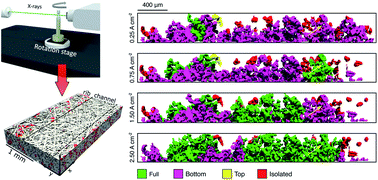Unraveling two-phase transport in porous transport layer materials for polymer electrolyte water electrolysis†
Abstract
In polymer electrolyte water electrolysis (PEWE), reducing mass-transport losses is crucial for lowering both PEWE capital and operational costs, allowing the widespread commercialization of the technology. In this work, we elucidate the complex two-phase flow (oxygen/water) developing in representative anodic porous transport layers (PTL) via operando X-ray tomographic microscopy. Thanks to a novel methodology based on the employment of stained water and a tailored data analysis pipeline, we overcome the long-standing challenge of visualizing the oxygen pathways in three dimensions in the titanium porous material, under representative operating conditions. Results show that two regions of stability develop inside the anodic PTL and the global oxygen saturation increases slightly with the increase of current density. The flow regime is found to be capillary driven and oxygen saturation is higher at the PTL/catalyst layer interface. At low current densities, oxygen pathways appear as separated clusters that merge into bigger and better-connected pathways at high current density. Analyzing the pore and water network size distributions, it is found that the oxygen phase initially occupies the bigger regions of the pore network while smaller pores are invaded at high current density. Finally, based on these findings, possible design guidelines for future better-performing PTLs are proposed.



 Please wait while we load your content...
Please wait while we load your content...